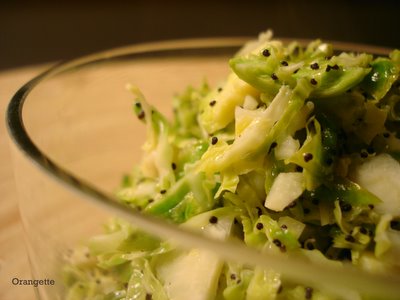The state of the sprout
I wait all year for Brussels sprouts. Many pine away patiently for October’s first pumpkins or November’s puckery cranberries, but I hang my hopes on a fresh fall Brussels sprout. This stance no doubt puts me in a minority—a happy one, meaning that entire market displays of sprouts are mine, all mine—but really, the state of the sprout in America today is a sad, sad thing. If another Thanksgiving dinner ends with a platter of Brussels sprouts still sitting untouched, we clearly have a national emergency, not a national holiday, on our hands.
For many, the merest mention of Brussels sprouts conjures up childhood visions of bitter, mushy, nose-wrinkling wads of cruciferous terror. I’ve seen even the most ardent of food lovers shrink before a pile of the little green orbs. This unfortunate aversion usually stems from one of two roots. First, Brussels sprouts are often cruelly boiled past their bright, verdant prime into olive-green oblivion, turning even the sweetest sprout bitter. And when overcooking is not the culprit, many cases of Brussels sprout phobia can be attributed to simple seasonality. Though sprouts can be found in the supermarket nearly year-round, they are markedly better—sweeter, with tighter, more compact heads—in the cold months. According to the lovely folks at Willie Green’s Organic Farm, sprouts that have weathered the first frost are much tastier than their spring- or summertime counterparts, which explains why I wait all year to, come fall, get my fill.
And that’s exactly what I do. Sometimes I roast them, halved and tossed with olive oil and sea salt, in a hot oven; sometimes I halve and sauté them with chestnuts. I’ve eaten more than my fair share of Brussels sprouts braised and glazed with a handful of whole peeled shallots, and I’ve heard rumors of bewitchingly good blanched sprouts sautéed in butter with red grapes and toasted pecans. But when Thanksgiving rolls around, you’ll find me at the stove with a skillet of hashed Brussels sprouts with poppy seeds and lemon.

Tossed in a hot pan for a scant five minutes, the sprouts soften and give up their starchiness, wilting into a warm slaw scented with white wine and citrus. It’s a method my family stumbled upon several years ago, and a shoo-in for our holiday table. Come Thursday, we’ll unite in Oklahoma—Seattlites, New Yorkers, and those in between—to hash away at another year, giving thanks for another fall, another Brussels sprout, and a very happy minority.
Hashed Brussels Sprouts with Poppy Seeds and Lemon
Inspired by The Union Square Café Cookbook
This recipe has brought many skeptics over to the pro-sprouts team. If you find yourself likewise converted and hungry for more, try this, this, this, or this. A whole universe is opening before you.
About 1 ¼ lbs Brussels sprouts
1 ½ Tbs fresh lemon juice
2 Tbs olive oil
1 medium garlic clove, minced
1 Tbs poppy seeds
¼ cup white wine
¼ tsp salt
Cut the stems from the Brussels sprouts and remove any blemished leaves. When all the sprouts are trimmed, you should be left with about 1 pound total. Halve each sprout lengthwise, and slice each half into thin slices, about 1/8 inch thick; or, alternatively, hash them in a food processor fitted with the slicing disc attachment.
In a large bowl, toss the hashed Brussels sprouts with the lemon juice.
In a large skillet or sauté pan, warm the olive oil over high heat, almost to the smoking point. Stir in the hashed sprouts, garlic, and poppy seeds. Add the wine, and cook for about 3-4 minutes, stirring constantly, until the sprouts are bright green and lightly softened but still barely crunchy. Reduce the heat to low, season with salt, and cook for 1 minute more. Remove the pan from the heat, and serve.
Yield: About 4-6 servings.

